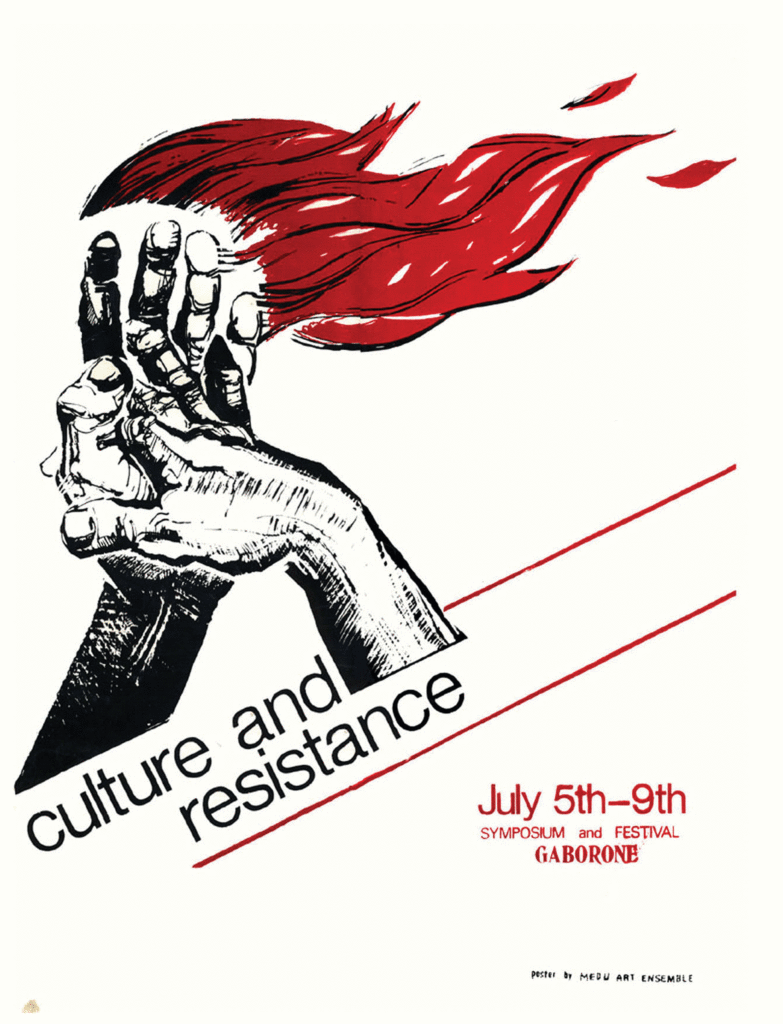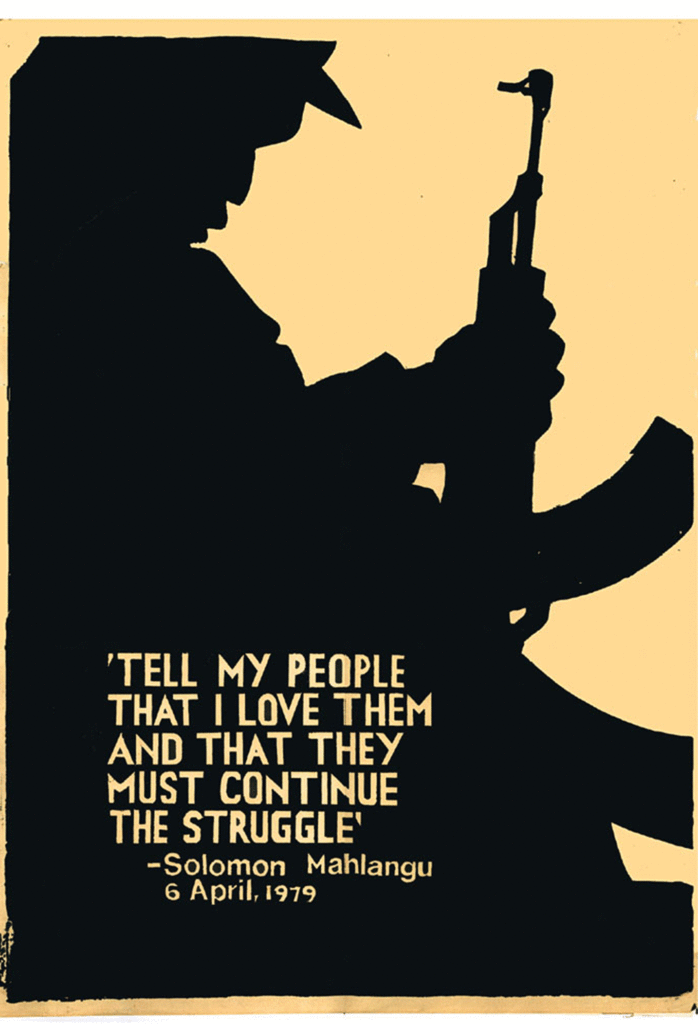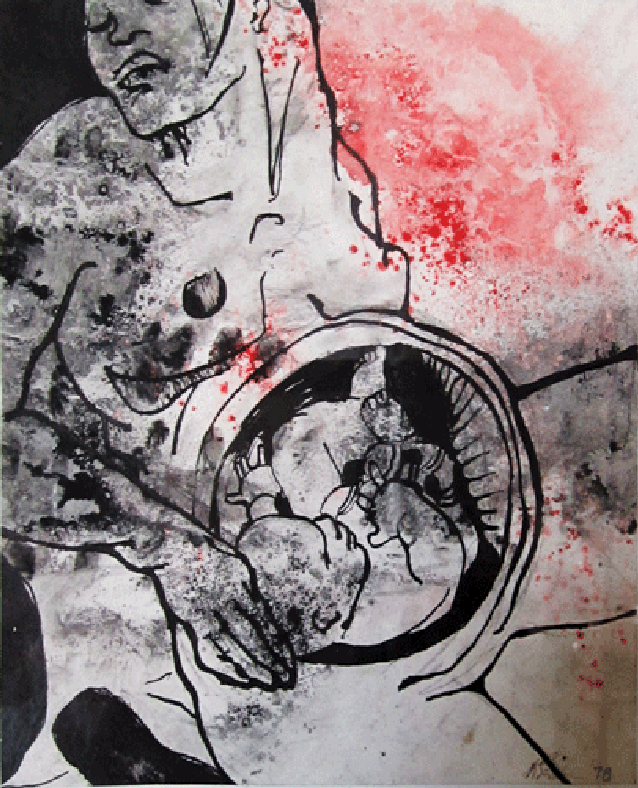Road work team, 1976 (Judy Seidman)
Together with Wits History Workshop, I organised the Drawn Lines exhibition in the naive and optimistic belief that it might open discussion on the cultural movement within the liberation struggle – a discussion that has been sadly lacking in South Africa for the past 30 years.
Instead of the hoped-for discussion, well-known arts writer Athi Mongezeleli Joja has, in the Mail & Guardian, expanded his assessment of the Drawn Lines exhibition and the art of the liberation struggle in an opinion piece replete with ad hominem attacks; unproven premises; ungrounded, idealist assertions; and little attention to facts. Although depressing, his response highlights the huge gap in historical study, theory and political debate around this critical period of South Africa’s cultural history. But since I hoped for and requested a debate, let me respond to Joja’s input.
The headline of Joja’s article, “Pretentions of fighting for the oppressed and the totality of white power”, summarises his approach to the art of the liberation struggle and the Drawn Lines exhibition.
As that title indicates, Joja argues that any claims made by a white artist to believe in and fight for oppressed black people must be “pretentions”, hiding “an insidious, self-interested spirit”. This, he opines, is an inevitable outcome of the “totality of white power”. He asserts that white people participated in the culture of resistance to manipulate and direct it, aiming to preserve the exploitative and oppressive white power structure. The culture of resistance thus ceased to be a “people’s culture”, but became merely a construct of the oppressor.
He writes: “White people have amassed symbolic and financial dividends from black subordination, including their resistance cultures … the culture of resistance constructs the subjectivity of ‘a people’, that is on one side parasitic to the specificity of the black suffering and, on the other, presides over that suffering’s ensemble of questions to ensure the preservation of the racial order”.
Joja locates this argument within the American theory of Afropessimism, citing Tamara Nopper’s essay, The White Anti-Racist is an Oxymoron, which he seems to conflate with Black Consciousness. The discussion of Afropessimism requires a separate article, but it is worth noting that one of its key principles — the dominance of white radicals over blacks in racially integrated struggles — is the mainstay of Joja’s approach to South Africa’s liberation struggle and its culture of resistance.
Thus he states: “… Trade unions and other worker formations have been historically dominated by white radicals … pumping money and resources into them”.
On the ANC and the Freedom Charter, Joja writes: “By 1979 … white inclusion … was a position geared towards exterminating the long shadow the Azanian tradition cast over the white left and liberals alike in the wake of the 1955 Freedom Charter.”
On the culture of resistance, Joja argues that visual artist Thami Mnyele “advanced a caricature of Black Consciousness-aligned cultural movements’ exclusion of white people, reducing its criticism of white allies to empty talk because it was no ‘less hurtful to be slapped in the face by a black policeman than a white one’.”
 Thami Mnyele, Poster for Culture and Resistance Festival, Gaborone, 1982
Thami Mnyele, Poster for Culture and Resistance Festival, Gaborone, 1982
If Joja had engaged more fully with Mnyele’s explanation of how Black Consciousness shaped his theories, he would realise that Mnyele’s theory of South Africa’s struggle culture was shaped by Steve Biko’s core concepts of self-awareness and self-determination; these principles of liberation culture hold whether or not whites participate in the movement.
This undercuts Joja’s dismissal of “former Black Consciousness adherents repeating after their new leaders that Black Consciousness was an inane stage in youth that prepared them for their political maturity: the ANC … Being an adult, much as being sentient, is after all associable with white people.”
As evidence for these sweeping statements about the culture of resistance, Mr Joja focuses on my artwork and participation in the liberation struggle. After the assertion that “White people have amassed symbolic and financial dividends from black subordination, including their resistance cultures…”;, he proceeds to dissect my work and actions to demonstrate that these form a classic example.
But assertions about my work can, and must, be subject to basic fact-checking.
How, asks Joja, can “some things, said to be belonging to Medu, become itemised as belonging to one member’s collection” — “how, for instance, essential items such as 1982 Culture and Resistance conference proceedings/papers, and collectively realised silkscreen posters, can be reduced as personal property of a single member, à la the Judy Ann Seidman Collection? [This] simultaneously appropriates and negates the labour of others, such that they become extensions of the figure to whom the collection ‘belongs’.”
To answer his (rhetorical) question:
From 1980 to 1985 I was a working artist with the Medu Art Ensemble, in the graphics, research and publications units. As secretary of the graphics unit (which Mnyele headed), I was tasked with keeping three copies of all posters produced by Medu for the historical record. Medu had no formal office, and most Medu members were exiles who regularly changed living spaces; therefore, we stored the Medu copies in my house. (Yes, we discussed the privileged access of a middle-class, white woman.)
The collective gave me responsibility for preserving these as part of South Africa’s national heritage, a responsibility I am still bound by. I also kept copies of all work I created myself and with the collective as my own portfolio; sometimes, there were several copies of these. (Because posters and newsletters are produced in print runs, these are called “original copies”.)
After the Gaborone Raid, Medu abruptly ceased to exist. As the surviving member of the graphics unit in Gaborone, I sent one full set of Medu posters for safe-keeping to the ANC in Lusaka, and another to the Nordic Africa Institute in Uppsala, Sweden. The latter was covered by a written agreement signed by myself and Barbara Masekela (as head of ANC cultural structures) that they must be returned to a free South Africa. (We were fully aware of the dangers of African heritage being kept overseas as imperial plunder). The third set of Medu posters, as well as my own personal portfolio, I kept in Gaborone,.
 J Seidman, ‘Solomon Mahlangu‘, with Medu Art Ensemble, silkscreen, Gaborone, 1982
J Seidman, ‘Solomon Mahlangu‘, with Medu Art Ensemble, silkscreen, Gaborone, 1982
The collection held by the ANC was exhibited internationally throughout the late 1980s. Some pictures were removed from the set; the returning ANC placed the remainder in the Robben Island Museum collection.
I inquired in the late 1990s about the Medu posters in Sweden. I was informed that they had been handed over to the South African Department of Arts and Culture in 1996. Subsequent inquiries failed to discover who received them on the department’s behalf, or where they were held. The posters have not been in public view since.
Without investigating what happened, Joja concludes that I refused to place Medu posters with the new South African government because I distrusted new black government officials, reflecting “an arrogant, Western dismissive tone that African states do not have adequate facilities sophisticated enough to care for their own historical objects”.
In reality, I suspected that the department officials who received the Medu collection from Uppsala in 1996 were civil servants transferred from the apartheid-era education department structures (Christian National Education and Bantu Education), and no, I was not willing to trust them with the last remaining set of Medu posters.
I placed the last set of Medu posters with the South African History Archive, a nongovernmental organisation designated as the repository for struggle history. They are there today, together with about 5 000 political posters from inside and outside South Africa. These have been documented, digitised and are publicly available to researchers and other users. I was employed as the head of the poster collection to do this, and subsequently wrote the book Red on Black, the Story of the South African Poster Movement.
I still had posters in my personal portfolio. I subsequently loaned some of these to public exhibitions at the Botswana Museum and Gallery in Gaborone, and to the Johannesburg Art Gallery (JAG) exhibit in 2009. JAG returned the posters to me when the exhibition closed; I later donated those to the Freedom Park collection, to complete the set given to Freedom Park by Sergio-Albio González (whose gift Joja notes approvingly).
 J Seidman, Pregnancy 1, pen and ink, powder paint, Manzini, 1978
J Seidman, Pregnancy 1, pen and ink, powder paint, Manzini, 1978
Today, I retain my portfolio, which includes Medu posters that I worked on, collectively and individually. For the record, I have never “hired these out” for a fee, either locally or internationally. (This was the untrue and defamatory allegation the M&G removed from an earlier version of Joja’s article.)
When museums display such items on loan, they caption them as “from the collection of … ” to demonstrate their provenance, not to assert private ownership.
I have made digital copies of posters, newsletters and conference papers available to multiple researchers and collections. A full set of Medu newsletters from my personal collection has been left with Chimurenga in Cape Town, on the understanding that they will digitise and put the full set online, a project that is not yet completed.
Some years ago, Freedom Park, under then chief executive Mongane Wally Serote, arranged to publish the Culture and Resistance Conference papers. Sergio-Albio González was asked to prepare them for publication; this was not done. Two years ago, I suggested to Freedom Park that this must be completed urgently, and volunteered to do so; I still await a decision.
I have been instrumental in establishing that all Medu graphics are registered under Creative Commons copyright to ensure these are freely available for all educational, historical and cultural purposes.
Some further fact-checking. In both his first and second articles, Joja denounces in my exhibition “the absence of white people except as recorders of the [black people’s] bodies, strife and existence”.
Fact: there are pictures of white people in the Drawn Lines exhibition Two are self-portraits (Pregnancy 1 and Pregnancy 2). Earlier figurative drawings described by Joja as “black people as stationary models to be looked at”, are all of white models (drawn in Madison, Wisconsin).
Presumably, having convinced himself that I never paint white people, he saw what he expected to see. Several other paintings show socio-structural relations between black and white people under apartheid (also based on life sketches from my first trip through South Africa in 1975).
Mr Joja uses this incorrect claim that I only ever portray black bodies as proof of my “devious agenda to hold black emancipatory power at bay”, and as part of “a broader study of exoticism … whereby the function of appearance has an asymmetrical relationship with how things really are, [turning] black people into objects for artistic representations and consumption, but not masters of their destiny”.
The logic of this is also troubling. Mr Joja begins that paragraph by remarking that “Seidman’s artworks portray black people with agency and commitment”, and concludes it by saying these pictures portray “the decorative utility of objects (read black people).”
 One of four One in Nine Panels that were included as part of the Drawn Lines exhibition. (Supplied)
One of four One in Nine Panels that were included as part of the Drawn Lines exhibition. (Supplied)
Joja persistently rejects all my statements about the nature, structure, and achievements of both Medu and the One in Nine cultural collectives. In the exhibition, I quote Mnyele about the theory and praxis of Medu. Joja ignores this, denouncing my statements about the importance of collective artwork as “a self-effacing attitude” that disguises “the white radicals’ trick of the trade … to dissolve into ‘the people’ in form while keeping a firm grip on the steering wheel”. In this perception, I am lying, and Mnyele was either my dupe or my minion.
In terms of One in Nine, he depicts me as “the director, artist and the brains behind the act …” He rejects all statements that the women in One in Nine created this work without my dread (unseen) hand directing them. “We see them, but hear her. Black people saturate the visual, languishing under their sorrows, but the structure, the frame from which we view them, is a borrowed one” — thus proving “pretensions of collectivity, which we’ve already established that Seidman uses as a magic wand to hide an insidious, self-interested spirit.”
Joja’s inapt description of the artwork made by these women as “languishing in their sorrows” possibly speaks to his tendency not to see past his own preconceptions.
Joja complains that “instead of dealing with the consequences” of his review of my work, I had the temerity to propose he should “conduct field work”, and ask One in Nine Campaign members about their views of the process. He concludes this would serve no purpose, since “Considering the subtle self-vouching assertiveness and the racial dynamics at play in the show, the likelihood of a contradictory statement might very well jeopardise any black woman who dares to speak out of turn.”
Joja’s approach is reminiscent of Keorapetse Kgositsile’s complaint at the Culture and Resistance Conference in 1982, about critics who seemed to think that: “… in the Liberation Movement there was no room for the literary artist to create; that possibly some frustrated thug with itchy fingers, and too cowardly to confront the boer fascists, spends his time dictating lines of whatever non-literary garbage to the supposed poet at gunpoint like some foul-mouthed movie gangster …”
Joja appears to be updating that scenario, casting me as the thug with itchy fingers, using white power and privilege to dictate to terrorised and subdued artists, promoting my malicious schemes to silence people’s voices; while the (black, powerless) art-makers mutter “yes, madam” and follow orders. He further extends this caricature to the whole of “resistance culture”. In his version, none of us — Mnyele, Kgositsile, Mpumi Mathabela (head of One in Nine), or myself — has the capacity or spirit to challenge the system of racial oppression and subjugation, or the will to create a different world.
I do not accept that. We in art-making collectives did not and do not accept that. Rather, we need to reclaim the cultural movement that Mnyele described, decades and lives ago: “… there are just the beginnings of a new approach to art growing at home. As the grassroots organisations gain in strength, some artists are finding a new home for themselves and their work … Let us dip our brushes into bold colours of paint and confidence and let us daub our walls with murals, posters, writings, cartoons, all soaked in the conscious language of revolution. We must restore dignity to the visual arts. The writing is on the wall.”